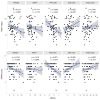Associations between physical fitness, body composition, and heart rate variability during exercise in older people: exploring mediating factors
- PMID: 39346081
- PMCID: PMC11439397
- DOI: 10.7717/peerj.18061
Associations between physical fitness, body composition, and heart rate variability during exercise in older people: exploring mediating factors
Abstract
Background: Age-related changes in body composition affect physical fitness in older adults. However, whether the autonomic response is associated with body fat percentage and its implication for physical fitness is not fully understood.
Aim: To understand the association between physical fitness, body composition, and heart rate variability in older people and its mediating factors.
Methods: A cross-sectional study with 81 older adults was conducted, assessing Short Physical Performance Battery (SPPB), Two-minute Step Test (TMST), body composition, and cardiac autonomic response. Correlation and mediation analyses were performed.
Results: Body fat percentage negatively correlated with physical fitness (SPPB: r = - 0.273, p = 0.015; TMST: r = - 0.279, p = 0.013) and sympathetic activity (sympathetic nervous system (SNS) index: r = - 0.252, p = 0.030), yet positively correlated with parasympathetic tone (root mean square of successive differences (RMSSD): r = 0.253, p = 0.029; standard deviation of NN intervals (SDNN): r = 0.269, p = 0.020). Physical fitness associated with sympathetic nervous system index (SPPB: r = 0.313, p = 0.006; TMST: r = 0.265, p = 0.022) and parasympathetic nervous system index (TMST: r = - 0.344, p = 0.003). Muscle mass mediated body fat's impact on physical fitness, while physical fitness mediated body fat's impact on autonomic response.
Conclusion: Body composition and cardiac autonomic response to exercise are associated with physical fitness in older people, highlighting a possible protective effect of muscle mass against the decline in physical fitness associated with increased body fat.
Keywords: Aging; Anthropometry; Exercise; Exercise test; Heart rate; Performance.
©2024 Mabe-Castro et al.
Conflict of interest statement
The authors declare there are no competing interests.
Figures





Similar articles
-
THE EFFECT OF OXIDATIVE STRESS ON THE AUTONOMIC NERVOUS SYSTEM IN PATIENTS WITH LIVER CIRRHOSIS.Georgian Med News. 2020 Jan;(298):94-99. Georgian Med News. 2020. PMID: 32141858 Clinical Trial.
-
Physical activity and aerobic fitness are positively associated with heart rate variability in obese adults.J Phys Act Health. 2014 Nov;11(8):1614-21. doi: 10.1123/jpah.2012-0405. Epub 2014 Feb 5. J Phys Act Health. 2014. PMID: 24508687
-
Regular physical exercise improves cardiac autonomic and muscle vasodilatory responses to isometric exercise in healthy elderly.Clin Interv Aging. 2017 Jun 28;12:1021-1028. doi: 10.2147/CIA.S120876. eCollection 2017. Clin Interv Aging. 2017. PMID: 28721030 Free PMC article.
-
The aging cardiovascular system: changes in autonomic function at rest and in response to exercise.Int J Sport Nutr Exerc Metab. 2001 Dec;11 Suppl:S189-95. doi: 10.1123/ijsnem.11.s1.s189. Int J Sport Nutr Exerc Metab. 2001. PMID: 11915920 Review.
-
Effects of weight changes in the autonomic nervous system: A systematic review and meta-analysis.Clin Nutr. 2019 Feb;38(1):110-126. doi: 10.1016/j.clnu.2018.01.006. Epub 2018 Jan 9. Clin Nutr. 2019. PMID: 29395374
Cited by
-
Enhancing cardiovascular monitoring: a non-linear model for characterizing RR interval fluctuations in exercise and recovery.Sci Rep. 2025 Mar 13;15(1):8628. doi: 10.1038/s41598-025-93654-6. Sci Rep. 2025. PMID: 40074820 Free PMC article.
References
-
- Baevsky RM. Methodical recommendations USE KARDiVAR SYSTEM FOR DETERMINATION OF THE STRESS LEVEL AND ESTIMATION OF THE BODY ADAPTABILITY standards of measurements and physiological interpretation. 2008. https://api.semanticscholar.org/CorpusID:29215863 https://api.semanticscholar.org/CorpusID:29215863
MeSH terms
LinkOut - more resources
Full Text Sources
Medical

